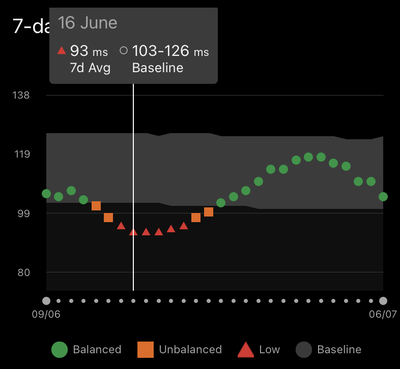Heart Rate Variability (HRV) has long been a topic of interest for athletes, coaches, and health enthusiasts alike. It serves as a non-invasive biofeedback tool that offers insights into our body's response to stress and recovery.
For me, it’s been a 10-year analysis of my own data from both a performance and lifestyle perspective. I’ve tried most apps to monitor HRV but the one I always go back to is HRV4Training by Marco Altini, who’s widely recognised as one of the leaders in this field.
Our paths with Marco crossed after he used PH 1500 to help overcome cramping during his sub-3 hour Manchester Marathon, and I had the great pleasure of chatting with him to delve further into the topic of HRV. I’ve outlined the key takeaways from our discussion to help inform your use of HRV data…
Understanding HRV
Your heart rate doesn't beat uniformly like a metronome; instead, there’s natural variability between the beats. This variability (or HRV) is orchestrated by our autonomic nervous system and indicates how our body responds to stress.
For athletes, stress can come from strenuous training sessions or lifestyle factors. Monitoring HRV can help you make necessary adjustments to training, thereby preventing negative responses and promoting better outcomes in the long run.
HRV: A Personal Metric
An intriguing aspect of HRV is its individualistic nature. Similar to how our fingerprints uniquely define us, our HRV is highly personal and can vary considerably between individuals. It's influenced by factors such as age, fitness level, and lifestyle. As such, comparing HRV values between individuals is less meaningful than observing changes in your own HRV over time.
Tracking HRV: Single Reading vs. Continuous Monitoring
The debate between single morning readings (e.g. using the HRV4Training app on your phone) versus continuous 24-hour monitoring (e.g. using an Oura ring or Whoop band) is an interesting one.
According to Marco, both methods hold value, and the choice between them often boils down to an individual's routine and preference. While a single morning reading provides an immediate snapshot of your resting physiology, continuous monitoring offers a broader picture of your physiological changes across different states of activity and rest.
Interpreting HRV: A Balanced Approach
Interpreting HRV isn't about fixating on a single reading or chasing an 'optimal' value. The key lies in observing how your HRV changes over time. You establish what's normal for you by tracking your HRV over several weeks. Significant deviations from this norm often indicate stress or illness.

However, Marco cautions against knee-jerk reactions to sudden drops in HRV. Instead, he suggests observing the trend over a few days and considering other symptoms before deciding to modify your training routine.
HRV Measurement Position: Lying Down, Sitting or Standing?
Fresh news this one. For the longest time (about 9 years and 10 months of the 10 years I’ve been tracking my HRV), I’ve always checked my HRV when lying down. However, just days before I interviewed Marco, he posted a new blog on the subject where he stated; ‘I now consider sitting the best and most effective way to capture data’.
To find out why head over to his Substack and read the full piece here.
HRV: A tool, not a crystal ball
Some users of HRV monitoring have reported that low HRV readings can sometimes precede sickness, suggesting that HRV could serve as an early warning system for illness. In my own experience I have definitely used it for this.
However, Marco notes that this isn't always the case. Sometimes, HRV changes coincide with the appearance of symptoms (that 'old correlation doesn't imply causation' nugget). Nevertheless, having an additional metric to monitor one's health can only be beneficial.
Race Day HRV: To Check or Not to Check?
Marco and I were in complete agreement on this one. Marco advises against checking HRV on race days as it could potentially lead to unnecessary stress. Excitement, nerves anticipation and the usual restless night might naturally cause lower HRV readings on race day, and this isn't necessarily a negative indicator.
In fact, some research suggests that a slight dip in HRV on race day can be normal and may not negatively impact performance.
HRV: It’s personal
Your HRV and how you interpret it is very personal. It doesn’t matter what someone else's reading shows. It’s not like your FTP or your run pace, which are easily comparable with others. So for sure track it, but there’s no need to broadcast what your status is. Keep an eye on it but don’t dwell on it.
Watch for warning signs and learn to interpret them in your context. Actually come to think of it, it’s very similar to your hydration and fueling strategy. It’s personal. What works is appropriate to you and nobody else.
In summary, HRV serves as a powerful tool that offers unique insights into our body's response to stress and recovery. However, as with all tools, understanding how to use it effectively is key.
So, whether you're an athlete aiming for peak performance or someone seeking to better understand your body's stress responses, keep in mind that HRV is a personal, dynamic metric best interpreted in light of your individual context and trends over time.
As I mentioned at the outset, Marco is a leader in this field and here we just touched on a few key subjects. If you want to get into the weeds then there’s no better place to start than with Marco’s blog at hrv4training.
